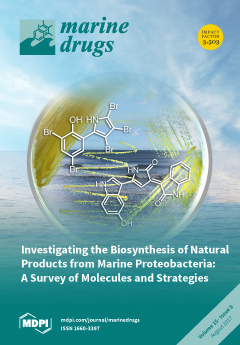Two new coumarin derivatives, 4,4′-dimethoxy-5,5′-dimethyl-7,7′-oxydicoumarin (
1), 7-(γ,γ-dimethylallyloxy)-5-methoxy-4-methylcoumarin (
2), a new chromone derivative, (
S)-5-hydroxy-2,6-dimethyl-4
H-furo[3,4-g]benzopyran-4,8(6
H)-dione (
5), and a new sterone derivative, 24-hydroxylergosta-4,6,8(14),22-tetraen-3-one (
6), along with two known bicoumarins, kotanin (
3
[...] Read more.
Two new coumarin derivatives, 4,4′-dimethoxy-5,5′-dimethyl-7,7′-oxydicoumarin (
1), 7-(γ,γ-dimethylallyloxy)-5-methoxy-4-methylcoumarin (
2), a new chromone derivative, (
S)-5-hydroxy-2,6-dimethyl-4
H-furo[3,4-g]benzopyran-4,8(6
H)-dione (
5), and a new sterone derivative, 24-hydroxylergosta-4,6,8(14),22-tetraen-3-one (
6), along with two known bicoumarins, kotanin (
3) and orlandin (
4), were isolated from an endophytic fungus
Aspergillus clavatus (collection No. R7), isolated from the root of
Myoporum bontioides collected from Leizhou Peninsula, China. Their structures were elucidated using 1D- and 2D- NMR spectroscopy, and HRESIMS. The absolute configuration of compound
5 was determined by comparison of the experimental and calculated electronic circular dichroism (ECD) spectra. Compound
6 significantly inhibited the plant pathogenic fungi
Fusarium oxysporum,
Colletotrichum musae and
Penicillium italicum, compound
5 significantly inhibited
Colletotrichum musae, and compounds
1,
3 and
4 greatly inhibited
Fusarium oxysporum, showing the antifungal activities higher than those of the positive control, triadimefon.
Full article






